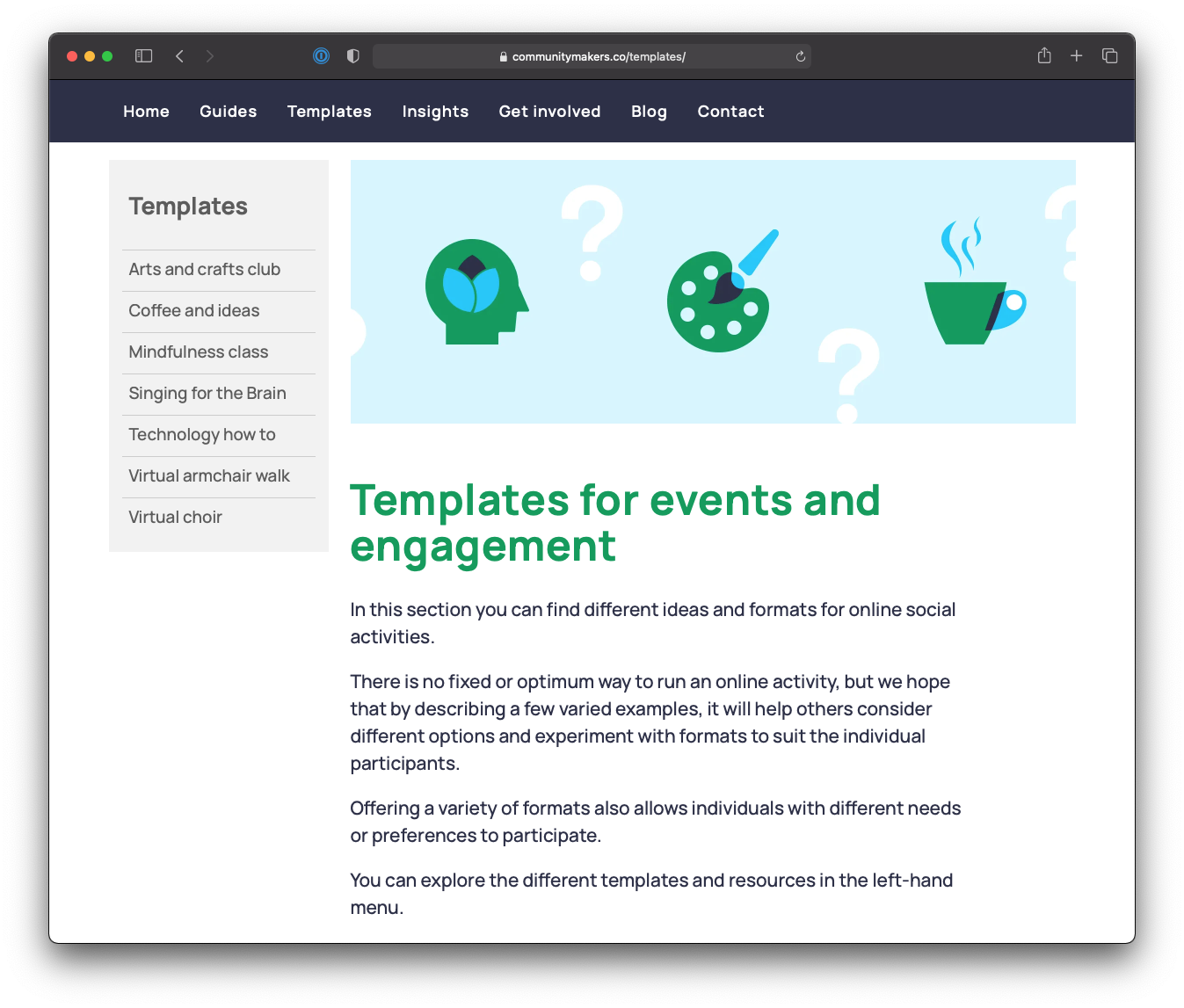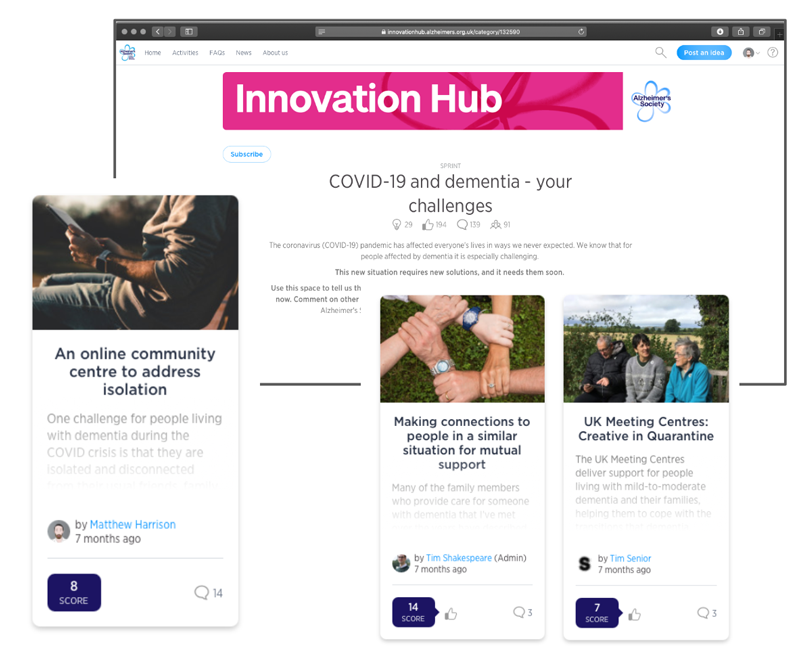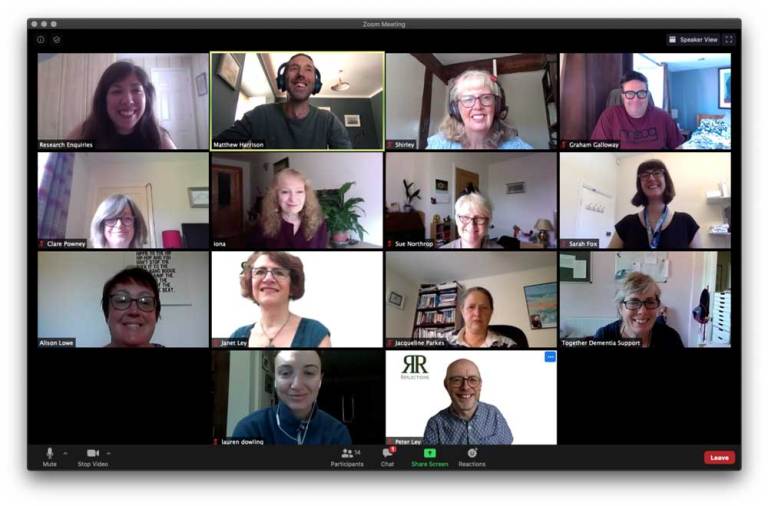
Community Makers
Collaborators
Dr Shirley Evans, Senior Research Fellow, Association of Dementia Studies, University of Worcester
Natasha Morgan, Senior Innovator, Alzheimer’s Society
Matthew Harrison, Designer, UK DRI & Helix Centre
Alice Blencowe, Designer, Helix Centre
and the Community Makers Network.
What is ‘Community Makers’?
As we entered the COVID pandemic in spring 2020, it became clear that the lockdown measures were going to be particularly difficult for people living with dementia. Firstly, people with dementia are generally older, with multiple health conditions, and so are particularly vulnerable to COVID-19. Secondly, people with dementia may find it harder to understand and adapt daily routines to isolate and maintain ‘social distance’. Thirdly, the community support that most families affected by dementia rely on broke down during the first lockdown. This put extra strain on primary carers, often elderly partners with their own health concerns.
The Alzheimer’s Society produced a report in October 2020 titled “Worst-hit; Dementia during Coronavirus” that showed Dementia to be the most common pre-existing condition of those who died of COVID. Twice the number of people with dementia died during March to June 2020 compared with the number that would normally be expected, and 82% of carers reported a deterioration of dementia symptoms during this period. We heard heart-beaking stories of people with dementia losing recognition of close family members as they isolated.
In April 2020 the Minder design team started collaborating with Alzheimer’s Society’s Innovation Team and the Association of Dementia Studies at University of Worcester to see how we could help address the situation, the resulting project is Community Makers.
Community Makers is a knowledge exchange network currently consisting of members from over 35 different community groups nationwide who are working to support people living with dementia and their carers. The need for such a network emerged due to the Covid-19 lockdown which forced numerous community groups to move their activities online. The primary aim of the network is to promote social connectivity whilst maintaining physical distance.
Establishing this network has enabled members to exchange ideas, seek advice and share experiences via an online forum and through regular online meetings. The Community Makers website is a public-facing toolkit sharing the information exchanged by this network. It seeks to inspire the creation of new community groups and help existing ones with digital involvement for people living with dementia and their carers. The website offers a library of resources including general insights, ideas for online activities, technology guides, and a summary of key considerations around setting up an online community.
The groups are from Scotland, Wales, England, both rural and urban settings, and include groups focussing on ethnic and minority populations. Groups within the network vary in size from those supporting over 150 people with dementia to new groups just setting up. One example is Dementia Matters Here(forshire), which was established directly as a result of our Community Makers collaboration.
Project stage

What were the aims and objectives of the project?
With people being increasingly socially isolated during the pandemic, unable to interact with their families and separated from local support networks that were previously in place, the UK DRI Care Research & Technology centre decided to partner with Alzheimer’s Society to develop a virtual community centre. Both organisations, along with the Association of Dementia Studies at the University of Worcester wished to explore the role technology could play in lessening the loneliness and isolation experienced amongst this already vulnerable group.

How was the project approached?
The project started through engagement with Alzheimer’s Society’s Innovation Hub, where they posted a COVID19 ‘challenge’. Members of the community contributed ideas and feedback, and we settled on an approach of creating a virtual community centre.

It was hoped that the envisioned virtual community centre would facilitate online carer support discussions and host social activities such as book readings, exercise classes and music listening groups via Zoom or other such technologies. The concept was presented in the early stages to people living with dementia, carers and campaigners through workshops organised by the Human-Centred Designers at the Helix Centre. Such workshops offered insight into how people with dementia were being impacted due to lockdown, the experiences of carers, and the challenges being faced by community group organisers trying to move their activities online.
It also emerged through user and community engagement, that many of the existing support groups had the networks and the trust within the communities they served, but didn’t have the digital skills to take their activity online. Of course, that is only one half of the story, people affected by dementia also needed support, advice, and sometimes equipment, to get online too, and the community groups were the obvious people to provide this support.
What role did Patient and Public Involvement and Engagement (PPIE) play in this project?
This project was driven and directed by the user feedback provided through workshops. For the outputs of this project to be appropriate for the target audience, it was vital to involve them at all stages of development. Hosting more than ten workshops enabled the team to gain a clear picture of the various problems being faced and allowed the concept to further evolve. Indeed rather than set up a virtual community centre, the workshops helped identify the need to help existing groups in the community go digital, and move their support online, so that they could continue to reach their members.

The team selected particular community organisers to form a focus group and explore ways in which to bring this concept to life. The importance of communication across the network was highlighted and various communication softwares were explored before settling on Slack, as it would enable network members to post to particular themed channels/forums and also send direct messages. The need to share insights beyond the group was raised in order to promote best practice and inspire others to set up an online community group. The team at Helix began prototyping content for the Community Makers website, which was subsequently reviewed by the focus groups. Members from across the network have contributed various insights and case studies to the website.
As the project progressed, so did the modes of engagement from the network. While activity on the Slack workspace waned, the online meetings between community organisers turned in to a valuable monthly event. A formal emerged where each month a member would share a case study of their experience of using digital tools, followed by an open discussion. Members have told us they value the network as a space to discuss ideas with peers, get feedback, advice and inspiration.
What were the key insights to emerge?
There have been many interesting insights as the pandemic has progressed. One of the first is that video conference calling is not the best way to engage many people with dementia, as it can be overwhelming. While the rest of society jumped onto Zoom (and also found it overwhelming), many people with dementia were left more isolated than ever.
However, a great many creative approaches were invented and shared among the Community Makers groups to keep in touch with people, make sure they felt included, remembered and heard. These ideas included groups making bespoke video tours of favourite beauty spots, to a memory jar exchange programme, to repurposing telephone conferring to suit dementia support groups. Swapping techniques for hosting virtual sing-alongs has also been popular.
Visit the Community Makers website to read more about the evolution of digitally enabled community dementia support over the last year.
What is next for Community Makers?
One of the silver linings of the lock down measures is that many older people have embraced technology as a way of communicating with friends and family. Indeed, software services such as Zoom and Microsoft Teams have adapted significantly over the last year to make their experience safer and easier to use. While it is fair to say that most groups are eager to re-embrace face-to-face contact when it is safe to do so, there were some significant benefits for some people in using digital tools. People who could no longer travel to physical community centres due to distance or mobility were able to engage through digital means, and people found new levels of connection and creativity through digital access to each other’s homes and pastimes. Carers in particular find video conferencing a good way to provide mutual support or access counselling services.
Another significant challenge for dementia community support is to help the people they look after re-emerge when it is safe to do so. Many people have lost the confidence to go out and socialise, as they have been so effectively warned about the risks of COVID19. One of the community groups has embraced nature, and bringing it into the home as a way to help people gain confidence in going out again.
It is clear that the need for digital tools and skills in this context will endure for a long time as face-to-face support grows again, but it is also probable that many community groups will maintain a ‘hybrid’ approach retaining the benefits of digital connection. The Community Makers project is currently consulting on this subject with the hope of attracting funding to support and facilitate these new models of digital and hybrid community support.
